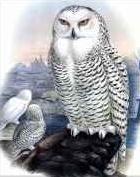 Welcome
to the Winter Quarter
Welcome
to the Winter Quarter
Winter is the Celtic season of sleep, the "Time Between" or "Silent Time." The clans gathered in winter steading where there was protection from wind and weather...many of the megalithic ruins in present-day Ireland and England were erected at sites where clanholdings were located. As do herds of wild animals in winter, the people gathered together for protection, aid and companionship. The sun is journeying to the uttermost north, and the seasonal alignments are north and northeast. The correspondences for the season are earth of water ( snow and ice) as well as fire of earth ( the dying sun) and earth of earth ( frozen ground, dead vegetation). The time of day is midnight, symbol of the hidden truths of nature as well as of the longest night of the year. The Winter season begins on the morning of Samhain, and lasts until the Dark Moon of Birch.
The colours for the season are midnight blue, white, dark grey, black, deep green, red and gold. They are representative of the midnight sky, the white starkness of the snowcovered land, the brooding grey skies, the bleak winter landscape of bare branches and evergreen needles, the red of hollyberry and the blood of winterkilled game, and the gold of midnight stars and the reborn Yule sun. Foods of the season are substantial, soups and stews and rich gravies and sauces, a legacy of a time when the cattle and sheep were slaughtered at the winter feast because there was no grass for them to eat, and of the needs of laboring men and women to eat well and substantially against the killing winter cold. As it was in ancient times, it is still a time for family gatherings and conviviality, as people came together to reassure themselves of the well-being of loved ones in the time of sickness and famine. All cultures from ancient times held some sort of festival in the midwinter as a reassurance of the re-emergence of light in the spring. Since there was no work in field or fold, crafts became the occupations of the long winter nights, and spinning and quilting, weaving and lacemaking, woodcarving and potterymaking, developed from skills for sustenance to art forms over centuries of long cold winters.
The Witch in winter is a seeker, looking to the secrets of night and starlight. There is time and quiet for long trancejourneying, as we seek to understand the ultimate mystery of death and rebirth. Long winter evenings lend themselves to the making of charms and the writing of memoirs, lore and stories to share with students, children or fellow-seekers on the Path. As we look to the rebirth of Light, candles are made and blessed for use in ritual throughout the year. Brews are concocted for colds and flu, for sound sleep and peaceful dreaming. Dreampillows are sewn from herbs gathered in summer and fall. And in a spirit of gathering together to face the darkness, many covens and groves do deep workings on the full and dark moons surrounding the Yule festival, as well as great gatherings of feasting and dancing and giftgiving at the Solstice.
In our mundane lives, we link to the Wheel in some ways we know, and others we are not aware of. Consciously, in winter people may make efforts to finish projects put off during the busy hours of summer and autumn. Many people send holiday letters which are reports of their activities and achievements during the year, the modernday equivalent of the ancient clanmoot, where the bards sang of each family's journeys and events since the last meeting. We decorate our houses for Yule with bright-colored lights, as ancient peoples built bonfires against the winter darkness. As did the old peoples, we reserve some of our most elaborate cooking and baking for winter festivals, as we revel in time the busy mobile life of urban summer did not afford, as well as creating delicacies as celebration of the persistence of life. Unfortunately, some people also suffer from the "Winter Blues" or holiday depression, as they demonstrate with their bodily cycles that despite modern conveniences we suffer as did ancient peoples from the long deprivation of sunlight. And despite claims of modern medicine, the old remedies of sleep, comforting foods (especially chicken soup!) and the companionship of friends and family still combat these ills as well s they ever did!
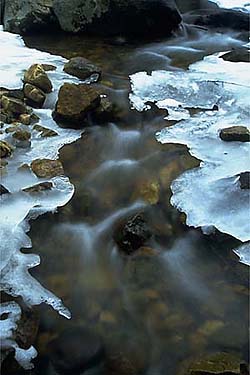
The elder tree is also considered a tree of wisdom. Celtic shamanism uses the elder tree to form the sacred hoop on which the shield of the shaman is strung, and fires of elderwood afforded dreams wherein the shaman could walk between the worlds and retrieve the wisdom of the ancestors. (This belief, that elder smoke produced visions, is probably the source of the prohibition against burning a fire of elderwood in the home hearth.) The Mighty Dead, wise ones of the ancient clans, were thought to take up residence in elder trees, whose branches then sighed their names when the wind blew. An Elder tree growing where no tree had been before, alone and separate from other trees, was probably a Witch enchanted, and such wood was never gathered....even the ground beneath such a tree was thought to be unlucky.
The Elder Moon contains the Solar Festival of Yule, or immediately precedes it. For Celtic traditional witches, the festival of Samhain marks the death of the Sun-King, and the weeks from Samhain to Yule are the "Silent Time" the "Dark Time", or the "Time Between." This is the time when the Sunlord rests in the belly of the Mother, and receives wisdom and arcane knowledge from his own Elder Selves, all the solar incarnations which have preceded the one to come. As far as the calendar goes, the Elder Moon may actually contain the festival of Yule, the Winter Solstice, or the moon may end several days before the Sabbat. If the latter occurs, the Dark Moon which precedes Yule is called a "Black Moon" as it is actually considered a second Dark Moon of Elder, rather than the Dark Moon of Birch, because the Solstice has not yet taken place, so the Year has not turned from Dark to Light. Such a moon is very powerful for communion with the Mighty Dead, elders of clan or tribe. In such a year, Yule falls after the Black Moon, and the Full Moon which follows is as always the Birch Moon and the beginning of the new Lunar Year.
The Celtic Tree Alphabet assigns the letter "R" to the elder tree. The bird of this season is the Rook, which is also a symbol of death. As well, the colour "Ruadh" (blood-red) is a symbol of the season. The energy of the Moon is "Ancient Wisdom" as we contemplate the endless cycles of birth and death and the many ways our own lives depend upon the lives of those who have gone before.





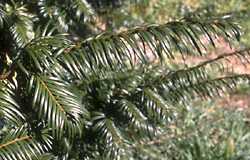
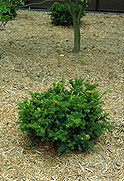
The Celtic Tree Alphabet lists the letter for the Yew as "Idho" which is the vowel "I" . The word "Irfind" in Old Irish means "very white"...the white of bleached bone or death. The Yew tree is sacred to the goddess Banba, one of the Celtic Triad, and a death crone goddess. The bird of this tree is the eaglet, whose name in Irish is "Illait", because like death its appetite is endless. The letter and sound also correspond to the Anglo-Saxon rune "Is" or "Ys" which is the rune of "ice" and which is the symbol of death.
The
season of Yew is short...it is the tree of the Winter Solstice, and so
has a "station" ( a single day) rather than a moon-month. Since the solar
and lunar calendars do not correspond exactly, the days between the Solstice
and the next moon fall in the Elder Month, as was mentioned above, and
the next moon after Solstice is a Birch Moon, whether full or dark. But
whether there are several days of the Elder moon remaining after the Solstice
or not, that day itself is sacred to the Yew, and is considered the Year-Day
( last day of the old year.)
![]()
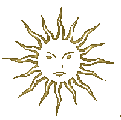

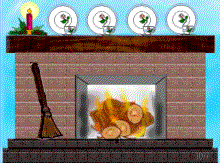

There is scarcely a custom of this season that does not have its roots in ancient lore, particularly that of the Celts. As did other ancient peoples, the Celts worshipped a fire-god, Bel, at this season. So the fire itself was seen as a sacred symbol, as it kept off predators, cooked food and provided warmth and light. The root of a tree was used to kindle the Yule fire as a remembrance that all life comes from that which has preceded it. Indeed, the remnant of the preceding year's Yule clog was saved to serve as kindling for that of the current year. Since ancient peoples believed that fire was a living creature which resided in the wood unless called forth, to them in a very real sense each year's Yule fire was the same fire as that of the year before, and the year before that, all the way back to the times before there were men, or fires, at all.
The Holly King, tanist of the Oak King and one of the faces of the "Two-Faced God," is the representation of the Dying Year, and the precursor of Santa Claus. The evergreen tree ( the silver fir which is the tree of the Celtic Tree Calendar) actually represents him as it is cut down and decorated to simultaneously represent his death for the land and rebirth as the Oaklord, Sun of the Mother. For this reason the tree is decorated with representations of fruits, flowers, gifts and colored lights, all symbols of plenty and abundance in the year to come. As we place gifts under and around the tree we recognize that in a very real sense all the gifts of life come to us from the death and rebirth of the God, which are actually seedtime and harvest, the gifts of the Year.
The carols we sing at this time of the year were originally all dance tunes ("carol" comes from the Old French word for "dance"). As we hear familiar tunes we can recall the spiral dance of life and rebirth, as well as the dances around the Bel-fire to coax the Sun back from the depths of winter's darkness. The Holly King is Lord of the Dance, and Witches honor him, and the spiral of life, with dancing, feasting and singing to renew the cycles of their own lives and the life of the land.

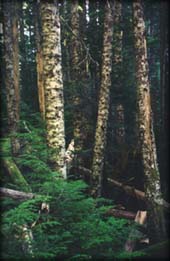
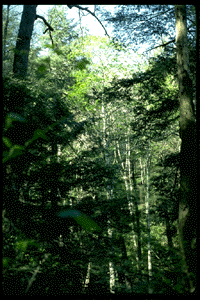

The birch is the first tree to bud in most of Western Europe and North America. Its branches bear both male and female flowers, an emblem of self-sufficiency. The flexible branches have traditionally been used for birch besoms, the tool of cleansing, and anciently flails of birch were used in ceremonial floggings to drive out the old energy, or the old year, and actual chastisement of delinquents.
![]()

![]()
![]()
![]()
![]()
![]()
![]()
![]()
![]()
![]()
![]()
![]()
![]()
The
word "Imbolc" or "Imbolg" is Irish for "in the belly," and is the festival
when the ewes who are pregnant begin to lactate and bear their winter lambs.
The feast is also called "Candlemas" and is known as the Feast of the Waxing
Light. In many traditions the Young God, born at Yule, is named by his
mother, the first name or "milk-name" by which he will be known until his
puberty at Spring Equinox. This is the first of the three sowing festivals,
and the new wheat is sown on the snow, to be nourished as it melts. The
festival is sacred in the Celtic traditions to the Triple Goddess Brighid,
who is patroness of poets, smiths, and healers.
![]()
Imbolc
is represented by the colors of fire and snow...silver, gold, red and white.
It is the time of the melting of ice and sometimes of the first buds on
leafless branches. The Goddess inspires us with the first warmer winds
to shake loose the frozen death of Winter in our souls, and to begin to
burn brighter within, to wax as does the light of day from the long night
of Yule. Traditional Celtic Craft holds Imbolc to be the best time for
initiations, as the symbolism of the new growth of light is congruent with
initiation.
![]()
Brighid,
Triple Goddess of the Celts who is honored on this feast day, is said to
be the patroness of poetry, smithcraft and healing. Therefore covens often
reserve Imbolc to perform original plays, poems or songs in Her honor,
as well as doing healing work or making things in circle to adorn the Temple
or covenstead. It is traditional at Imbolc to make handmade candles for
use in ritual throughout the year, as well as plaiting birch brooms and
making wands from birch.
